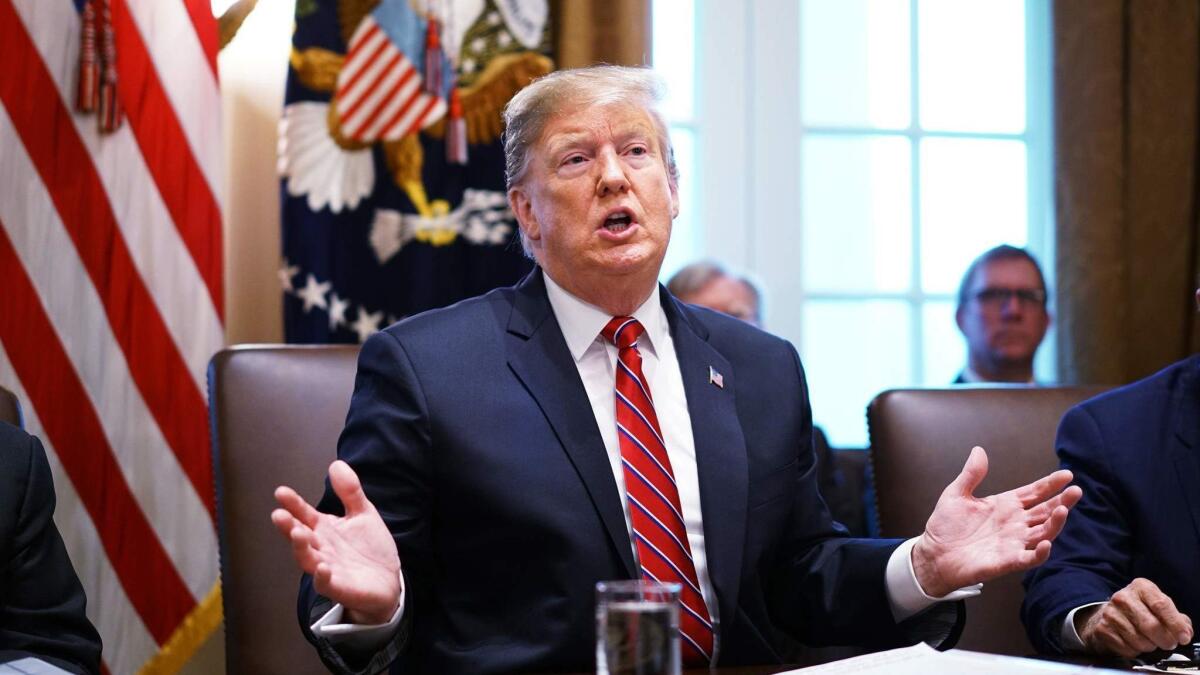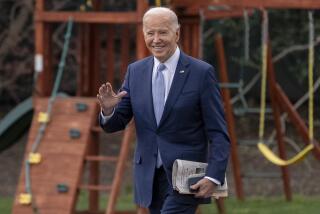Trump isn’t ‘thrilled’ with border deal, but says he doesn’t expect another shutdown

Reporting from Washington — President Trump on Tuesday said he was “unhappy” with the border security funding agreement crafted by a bipartisan group of lawmakers, throwing the fate of the spending plan into question days before the government would shut down again.
“I can’t say I’m thrilled,” Trump said at the White House. “I have to study it. I’m not happy about it. It’s not doing the trick, but I’m adding things to it.”
But he also said he doesn’t expect the government to shut down again, just weeks after a record 35-day partial stop in federal programs.
Top Republicans in the Senate implored Trump to sign the proposal, but rank-and-file lawmakers were more skeptical.
The $1.3 billion deal — which allows for border fencing but no walls — was reached late Monday. Legislative text is not expected to be released until Wednesday, said Sen. Richard C. Shelby (R-Ala.), one of the top appropriators who crafted the plan.
Senate Majority Leader Mitch McConnell (R-Ky.) said the deal is “not everything the president hoped to get but I think it’s a good step in the right direction. I hope he’ll decide to sign it. We’re all quite interested in that, as you can imagine.”
Republicans are understandably gun-shy. In December, the GOP-controlled Senate approved an earlier border deal — also without border wall funding — with the understanding that Trump would support it. But under pressure from conservatives, the president then reversed his position, complaining the Senate plan did not provide money for a border wall. When Democrats failed to agree to provide $5.7 billion for a wall along the southern border, the government shut down.
This time, Republicans want to make sure Trump supports the deal before they vote.
“We’ll just have to see,” Shelby said. “He could sign it. I think he’ll probably sign it. But he might not.”
“Nobody’s humming ‘One Shining Moment’ yet. I’m certainly not,” said Sen. John Kennedy (R-La.), referring to the song traditionally played at the end of the NCAA men’s basketball tournament.
Rep. Tom Graves (R-Ga.), a member of the conference committee that put together the plan, said he hadn’t seen the details yet and expressed skepticism. “I haven’t signed off on the reported ‘deal’ nor have I seen it,” he wrote on Twitter. “Based on the reports, I have concerns. Lots of questions too.”
Shelby and other GOP leaders framed the plan as a “down payment” on the wall. The president was briefed on the parameters of the plan by Shelby, Trump tweeted late Tuesday. The president didn’t weigh in on whether he would sign it.
In recent weeks, Trump has backed down from his demand for a concrete wall, and Republicans say fencing would be just as good as a wall. But Trump has also said that if Congress does not provide taxpayer funds for a wall, he will use his executive power or declare a national emergency to try to divert money from other military or disaster programs for a wall.
“Looking over all aspects [of the deal] knowing that this will be hooked up with lots of money from other sources,” he tweeted Tuesday.
Many GOP lawmakers are encouraging Trump to divert existing money, though some oppose declaring an emergency to do so.
The tentative plan calls for $1.375 billion in border fencing, well short of what Trump originally demanded for a wall, and even less than the $1.6 billion in fencing offered by Senate Democrats in December to avoid the shutdown.
During the 2016 campaign, Trump promised to build a 1,000-mile wall that Mexico would pay for.
The latest deal provides for about 55 miles of new fencing — such as “steel slats” or “bollard fencing” — to be constructed along the border in the Rio Grande Valley. It would not allow money to be used for a wall.
Democrats backed down from their earlier demand for new limits on the ability of U.S. Immigration and Customs Enforcement to detain immigrants.
The plan would fund the Department of Homeland Security — the agency at the center of the border security funding battle — as well as other agencies, such as the Environmental Protection Agency and the Interior Department. It is not expected to include funding for relief from disasters, such as the wildfires in California, according to a congressional aide.
Many Democrats in the House have not yet weighed in publicly. Progressives are wary of providing funding for more fencing.
But weeks after a lengthy shutdown, several lawmakers expressed deep skepticism about revisiting that territory. More than 800,000 federal workers went without paychecks and some only recently got back pay.
“It’s amazing how shutdown fatigue challenges your flexibility on things, and understandably so,” said Sen. Kevin Cramer (R-N.D.), who said he is likely to support the plan assuming the text matches the general framework floated by the conference committee.
Conservatives complained that the plan doesn’t fund a wall. But one of the groups most responsible for holding up bipartisan spending plans in the past — the conservative House Freedom Caucus — is not expected to jump into the fray.
“If this is the vehicle [Trump] uses to keep the government open, so be it,” said Rep. Mark Meadows (R-N.C.), chairman of the caucus, which lost much of its influence when Democrats took the House. “I don’t know that the Freedom Caucus has any leverage to go to the mats on it at this point.”
Meadows was one of several conservatives who convinced Trump to oppose the spending plan in December that led to the shutdown.
Still, the closer Congress gets to the funding deadline – money would run out on Friday evening – the more lawmakers would have to rush legislation through both the House and Senate. At that point, any one senator could use rules to block the legislation from being approved.
Kennedy suggested that Congress could stick with its well-worn tradition of arguing until the very last minute before deadlines.
“We’ve got three or four more days,” he said. “That may as well be a light-year around here.”
Times staff writer Sarah D. Wire contributed to this report.
More to Read
Get the L.A. Times Politics newsletter
Deeply reported insights into legislation, politics and policy from Sacramento, Washington and beyond. In your inbox three times per week.
You may occasionally receive promotional content from the Los Angeles Times.











